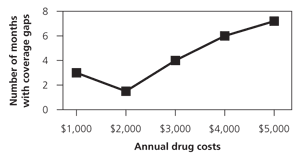
Am Fam Physician. 2006;73(3):404
Medicare Part D will lower medication expenditures for many older patients. However, its complex design incorporates a staggered series of cost-sharing mechanisms that create gaps in coverage and may have a negative impact on medication adherence.
Part D’s staggered cost-sharing mechanisms (i.e., a deductible, a coinsurance zone, a “doughnut hole,” and a catastrophic limit)1 will produce coverage gaps for individual patients—periods within any year where they are responsible for 100 percent of their medication costs. Although many prescription drug plans will eliminate deductibles and replace the 25 percent coinsurance zone with tiered co-pays, the majority will preserve the doughnut hole. This is the most significant cost-sharing mechanism and creates the biggest potential coverage gaps for patients.
To illustrate potential coverage gaps experienced under Part D, take the example of Mrs. Jones. She makes $19,000 per year (twice the federal poverty level) and spends $250 per month on medications ($3,000 annually). Under Part D she pays the first $250 of drug costs as a deductible, thus experiencing a coverage gap in her first month of enrollment. Over the next eight months, she spends another $2,000, of which she is responsible for 25 percent, or $500. Medicare covers the remaining $1,500. Her drug expenses now total $2,250, putting her into the doughnut hole. For the remaining three months of the year, she pays 100 percent of drug costs, or $750. By the end of the year, she has spent around $1,500 out of pocket on prescription drugs and another $384 ($32 per month) in premiums to take part in the plan. Medicare has spent $1,500. Overall, the patient has had four months of coverage gaps when she paid 100 percent of drug costs.
The 7 million beneficiaries projected to spend into the doughnut hole and beyond will have gaps in coverage that last from 1.5 to 7.2 months.1,2 This gap grows or shrinks based on total annual drug costs (see accompanying figure).2 A study3 of Medicare beneficiaries with drug spending limits and subsequent gaps in coverage similar to those resulting from Part D’s doughnut hole suggests that such patients are significantly more likely to engage in cost-lowering strategies such as taking less medication than prescribed or switching to cheaper medications. Two thirds of patients had difficulty paying for prescriptions, and this overall greater financial burden potentially jeopardizes other necessities such as housing and utilities.3

Part D will reduce the burden of prescription costs for most beneficiaries, but physicians should expect differing effects on individual patients depending on their coverage gaps. Efforts by benefit plan organizers and policy makers to smooth the month-to-month variability in coverage will be essential to maximize the positive impacts of Part D.